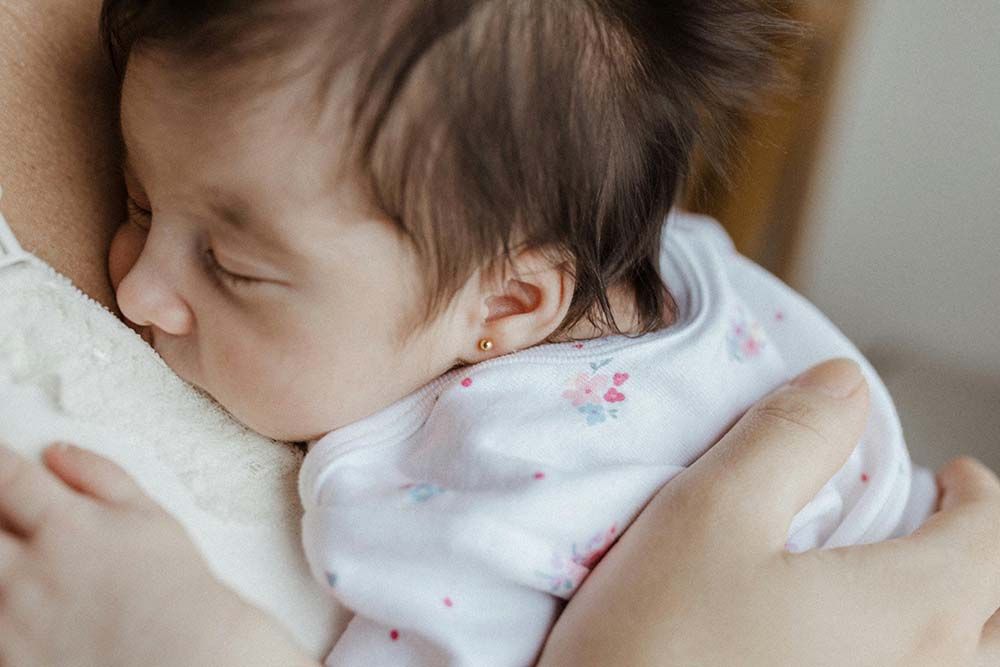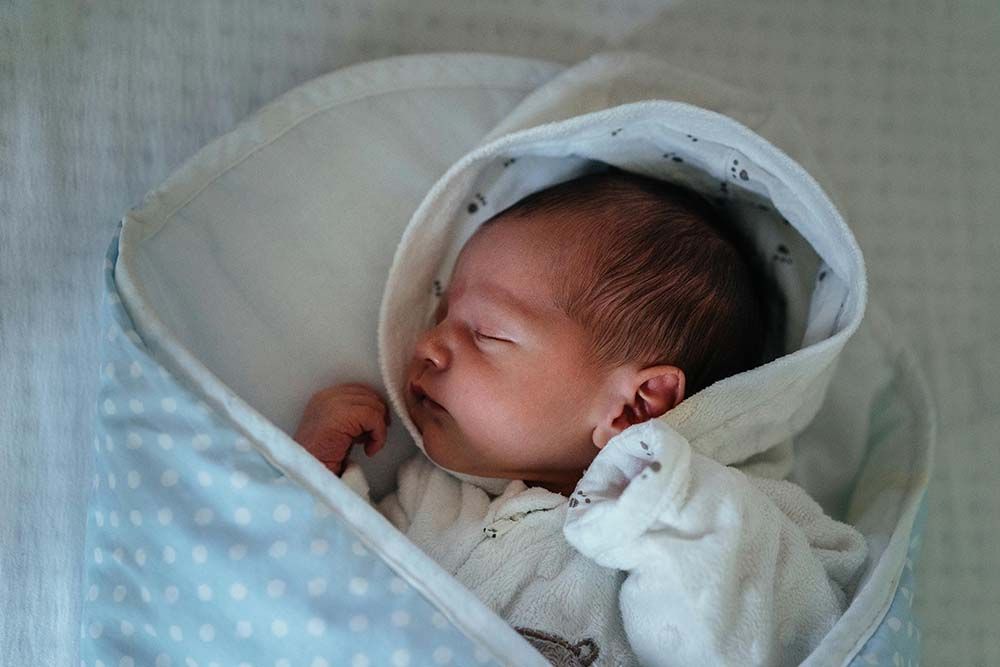

As your toddler approaches 23 months, you might notice some changes in their sleep patterns. With each passing month, your little one is becoming more independent and energetic, which often means their sleep needs evolve too. In this guide, we'll explore the sleep needs of 23-month-olds, offering practical tips and strategies to help you craft a balanced sleep schedule that supports their growing independence and energy levels.
Since every baby is unique, finding a suitable sleep schedule can be a challenge for parents, often requiring some trial and error. However, with a Schedule Creator tool like the Moonycare App, you can generate a personalized sleep schedule tailored to your baby's specific needs. This can help simplify the process of addressing sleep-related issues and ensure that your little one gets the rest they need.
IN THIS ARTICLE:
What are Wake Windows for a 23 Month Old?
A Sample Sleep Schedule for 23 Month Old Babies
Naptime Schedule for a 23 Month Old
Why Won’t my Baby Sleep? Is there a 23 Month Old Sleep Regression?
How to Get my Baby to Sleep? Can I Sleep Training my 23-Month-Old?
What are 23 Month Old Milestones?
What to do if you Have 23-month-old Twins?
What are Wake Windows for a 23 Month Old?
Wake windows, are crucial for a well-balanced sleep schedule. At 23 months, the average wake window ranges from 4 to 6 hours. This means your toddler should ideally stay awake for about 5-6 hours after waking up in the morning before their nap and then another 4-5 hours between the end of the nap and bedtime. It's important to monitor your child for signs of tiredness, as pushing them beyond their wake window can lead to overtiredness, which can negatively impact their ability to fall asleep.
Sample 23 Month Old Sleep Schedule
At 23 months, a typical sleep schedule might look like this:

This schedule ensures that your toddler gets the recommended amount of sleep while also accommodating their natural wake windows. But you don't have to carry out a completely same schedule, only if you baby can sleep well in his own pace.
Bedtime for a 23 Month Old
How Much Should a 23 Month Old Sleep?
At 23 months, toddlers generally need about 12 to 14 hours of sleep in a 24-hour period, including approximately 10 to 12 hours of nighttime sleep. Ensuring your toddler gets enough sleep is essential for their physical and cognitive development, as well as their overall mood and behavior.
What Time Should a 23 Month Old Go to Bed?
For a 23-month-old, bedtime is not just about a specific hour on the clock; it's a culmination of the day's activities, energy expenditure, and emotional readiness for sleep. Around this age, a bedtime between 7:00 PM and 8:00 PM is generally ideal, as it aligns with their natural circadian rhythm and allows for a full night's sleep. However, the key is to observe your child’s cues like yawning, rubbing eyes, or becoming less active, and then make adjustments accordingly.
Besides, to fall asleep smoothly, you can also create a predictable and soothing bedtime routine before sleep, which can significantly ease the transition to sleep. Thus, you can do some gentle activities like reading a favorite book, gentle rocking, or a quiet lullaby, which can not only help in calming your toddler, but also in establishing a sense of security. The winding-down period should start about 30 minutes before the set bedtime, allowing your child to relax and disengage from the day's stimulation.
Besides, try to keep bedtime the same even on weekends or after a particularly active day. This regularity reinforces their internal clock and makes falling asleep easier. On days when your child seems more tired or irritable, you might consider moving bedtime slightly earlier to prevent overtiredness, which can actually make it harder for them to fall asleep.
Can a 23 Month Old Baby Sleep Through the Night?
Generally, by 23 months, most babies are capable of sleeping through the night. As their brains continue to mature, toddlers are better able to enter and maintain deep sleep for longer periods. Additionally, their stomach capacity has increased compared to infancy, allowing them to consume enough food before bedtime to sustain them throughout the night. If a baby’s circadian rhythm has adjusted to a more regular pattern and they are in a safe, comfortable environment, it’s entirely possible for 23-month-olds to sleep through the night without waking.
However, every baby is different, and their sleep patterns can vary. Some toddlers may still wake during the night due to physiological reasons, such as teething discomfort, illness, thirst, a wet diaper, or the need to use the bathroom. Emotional factors, like separation anxiety or nightmares, can also cause nighttime awakenings. Additionally, sensitive toddlers may be easily disturbed by environmental changes such as noise, light, or temperature fluctuations, which can interfere with their sleep.
If a baby wakes up at night, parents can encourage them to self-soothe and return to sleep independently. If the baby continues to cry, providing comfort while gradually reducing nighttime interventions can help. This approach allows the baby to adjust to sleeping through the night while fostering greater sleep independence over time. As a result, both the baby and the parents can enjoy better-quality sleep.
23 Month Old Nap Schedule
1 - nap schedule
Morning rise: 7:00 AM
Nap: 12:00 PM - 2:30 PM (2 hour nap)
Perform bedtime routine: 7:00 PM
Fall asleep: 7:30 PM
How Long Should a 23-Month-Old Nap?
Baby at this age typically requires 2 to 3 hours for nap time. This nap helps to replenish their energy and maintain their mood throughout the day. If your toddler seems unusually cranky or overly energetic after nap time, you may need to adjust the nap's duration or timing.
How Many Naps Are Expected for a 23-Month-Old?
At 23 months old, most toddlers have transitioned to a single nap per day. This nap typically occurs in the early afternoon, helping to rejuvenate your child for the rest of the day and preventing them from becoming overtired by bedtime. However, the exact timing and length of the nap can vary depending on your toddler's individual needs and daily activities. At the meantime, it's crucial to maintain a consistent nap schedule to support their overall sleep routine.
What can I do if my 23 Month Old is not Napping?
If your 23-month-old baby doesn’t nap, parents can evaluate whether their toddle really do not need a nap by observing their behavior. If your baby is still energetic and emotionally stable without a nap, and is not obviously tired or irritable, it may mean that they no longer need a nap. However, if your child shows signs of fatigue without a nap, such as irritability, inattention or hyperactivity, difficulty falling asleep at night, or frequent night waking, it may be that the nap is too long or the nap time is not appropriate. You can try to adjust the nap time, shorten the nap time, improve the sleeping environment, adjust the routine before the nap, etc. to help your baby regain a good nap habit. In addition, do not arrange the nap time too late to avoid affecting nighttime sleep.
Some babies may no longer need a nap at this age, while others may need some time to stop napping completely. Considering to the uniqueness of each child, parents should not force their baby to take a nap. Instead, the key is to make adjustments based on the needs of the baby. If your baby really does not need a nap, it is important to make sure that they get enough nighttime rest and static activities during the day. By making flexible adjustments and observing your baby's needs, you can find the sleep pattern that suits your family.
When to Stop Nap?
Deciding when to stop your baby's nap is a very individual process, depending on your baby's age, personality, and sleep needs. Most children will gradually reduce or completely stop naps between the ages of 3 and 5, but each child develops at a different rate, so there is no fixed schedule that works for all children. Here are some guidelines and signs to help you determine when you can consider reducing or stopping your baby's naps:
- Your baby still appears energetic and emotionally stable in the afternoon and evening without a nap, and is not obviously tired or irritable
- If your baby falls asleep more easily at night without a nap and wakes less frequently
- If your baby begins to strongly resist naps, refuses to lie in bed, and even shows obvious dissatisfaction or anxiety. However, occasional resistance is normal. If this happens continuously, it may mean that your baby is ready to reduce or stop naps.
- If your baby's afternoon activity and emotional state are still good without a nap, and they are able to complete daily activities smoothly, this may indicate that they no longer need a nap to restore their energy.
In addition, it is not recommended to suddenly cancel your baby's nap, especially if they still appear tired or emotionally unstable. Gradually reduce nap times to give your baby enough time to adjust to the new routine. Even if your baby has reduced or stopped naps, they may still need a short nap sometimes on days when they are particularly tired. Be flexible and allow your baby to take a quiet rest or nap when needed, especially after a long activity or travel.
Why Won’t my Baby Sleep? Is there a 23 Month Old Sleep Regression?
The reason for a 23 month old not sleep can be various, including:
- Physiological issues: teething, hunger or thirst, toileting needs or diaper problems
- Physical discomfort: gastrointestinal problems, teething pain, ear infections, colds, allergies
- Emotional factors: separation anxiety, nightmares or fears, excessive fatigue or excitement
- Developing a certain sleep dependency (rocking, feeding, holding to sleep)
- Environmental factors or irregular sleep schedules
Baby sleep regression can affect baby’s sleep quality indeed, which can occur at any age of a baby. Sleep regression at 23 months can be a challenging phase for both parents and toddlers. Unlike the earlier sleep regressions that may have been more physically driven, this stage is often influenced by cognitive and emotional developments. Your toddler is growing more aware of their surroundings, their emotions, and their independence, which can manifest in disrupted sleep patterns.
At this age, your toddle might start resisting naps or bedtime, waking up more frequently during the night, or having difficulty falling back asleep. These changes are often linked to the emergence of separation anxiety, fear of the dark, or an increase in nightmares or night terrors. The desire for independence can also lead to power struggles at bedtime, as your toddler may tend to keep awake longer.
This regression is a normal part of development and usually resolves on its own as your toddler adjusts to their new cognitive and emotional abilities. With understanding and a supportive approach, you can help your child navigate this phase, leading to better sleep for both of you.
How to Get my Baby to Sleep? Can I Sleep Training my 23-Month-Old?
To help a baby fall asleep smoothly, here are some useful strategies after trying for the needed.
1. Pay attention to feeding and toileting needs
Adequate dinner: Make sure your baby eats the right amount of food before bedtime, and avoid overeating or eating irritating foods. You can provide your baby with some healthy light meals before bedtime, such as fruit, yogurt, or whole-wheat biscuits, to help them maintain their energy needs at night.
Toilet training: If your baby has started toilet training, you can take them to the toilet once before bedtime to reduce the possibility of waking up at night. Make sure your baby uses a dry diaper before bedtime to avoid discomfort caused by wet diapers.
2. Adjust activities
Sufficient daytime activities: Make sure your baby has enough activities and exercise during the day, which helps to consume excess energy and fall asleep easily at night. But avoid overly active exercises before bedtime to avoid making your baby too excited.
3. Deal with your baby's emotions and anxiety
Separation anxiety: Babies aged 23 months may experience separation anxiety, especially when falling asleep at night. If your baby is reluctant to fall asleep alone, you can give them more comfort and companionship to help them build a sense of security.
Soothe your baby’s fear: If your baby doesn’t want to fall asleep because of nightmares or fear of the dark, you can comfort them, tell them warm stories or make them feel safe. If needed, you can use a night light to ease your baby’s fear of the dark.
Provide comfort items: Provide your baby with a comfort item (such as a favorite stuffed toy or blanket) to help them feel at ease when they are not with their parents. These items can provide emotional support for your baby and help them fall asleep more easily.
4. Understand your baby’s needs
Physiological needs: If your baby wakes up and cries at night, check if they are physically unwell (such as wet diapers, hunger, toothache, etc.). Respond to your baby’s needs in time and let your baby go back to sleep after solving the problem.
Emotional needs: If your baby wakes up because of emotional distress (such as anxiety, fear, separation, etc.), try to comfort them by soothing, hugging, and whispering to help them relax and fall asleep.
If sleep issues persist, sleep training might be necessary. At 23 months, except for creating a comfortable environment for baby, there are many other effective strategies to help you navigate sleep training with your 23-month-old. And consistency and patience are crucial during this process.
1. Gradual Extinction (Ferber Method)
Gradual Separation: Start by sitting next to your child's crib or bed until they fall asleep. Gradually move farther away each night until you can leave the room.
Check-Ins: If your child wakes up, wait a few minutes outside the room before checking in. Gradually increase the intervals between check-ins.
2. Chair Method
Stay in the Room: Sit in a chair near your child's crib or bed and gradually move farther away as they become more comfortable.
Quiet Presence: Stay calm and reassuring, but avoid engaging in activities that might stimulate your child.
23-Month-Old Sleep Tips
- Avoid over-intervention: If your baby is used to nighttime intervention (e.g. you pick him up immediately when he cries), gradually reduce this intervention to help him learn to fall asleep on his own.
- Consistency: Stick to a regular bedtime routine to help your child wind down.
- Comfort: Ensure your toddler’s sleep environment is conducive to rest, with the room being dark, quiet, and at a comfortable temperature.
- Routine: Establish a calming pre-bedtime routine, such as reading a story or taking a bath.
- Be patient: Patience is key to navigate some sleep issues and keep good habits.
- Seek Professional Help: If you're struggling to resolve sleep issues, consider consulting a pediatrician or a sleep specialist for personalized advice.
What are 23 Month Old Milestones?
1. Physical Development
Motor skills: Babies are usually able to walk independently and may even start to run, although they may not be stable when running. Most babies are able to climb and run up stairs, and some may try to kick a ball, jump, or ride on small toys.
Fine motor skills: Babies are better able to use their fingers, can stack small blocks, and try to draw with pencils or crayons. Although the shapes they draw may still be messy, they are beginning to imitate adults in drawing simple shapes such as lines and circles.
2. Language Development
Vocabulary growth: Babies may say 50 words or as many as 100 by 23 months old.
Word combination: Many babies begin to try to combine two simple words into short sentences.
Comprehension: Babies can understand and follow simple instructions, such as "Give me the ball" or "Put the toy in the box." They begin to understand some basic concepts, such as "above," "below," "big," and "small."
3. Cognitive Development
Cause and effect: Babies begin to understand some simple cause and effect relationships, such as when they press a button, the toy will make a sound or light up.
Imitative behavior: Babies will observe and imitate the behavior of adults and other children, showing a strong interest in adult life. For example, they may imitate their parents' actions such as picking up the phone, sweeping the floor, or cooking.
Object permanence: Babies now have a better understanding of object permanence, that is, even if an object is out of sight, it still exists. For example, babies may go to find hidden toys and show greater curiosity and desire to explore.
4. Social and emotional development
Social interaction: Babies begin to show more social behaviors, such as playing with other children, sharing toys, or imitating others. Although they may not fully understand the concepts of sharing and taking turns, they may begin to try.
Emotional expression: Babies are more emotionally expressive and may show emotions such as attachment, fear, or anger. Crying is still their main way of expressing dissatisfaction or needs, but there will also be more non-verbal communication methods, such as pointing or using gestures to express needs.
Separation anxiety: Some babies may continue to experience separation anxiety, especially when away from their parents or primary caregivers, and may show restlessness and crying.
5. Self-care
Increased autonomy: Babies may begin to try to do things on their own, such as eating with a spoon or putting on and taking off simple clothing (such as socks) by themselves. They may show a strong sense of independence and want to make decisions and complete tasks on their own.
Readiness for toilet training: Some babies may show interest in the toilet or try toilet training with encouragement from their parents.
What to do if you Have 23-month-old Twins?
When caring for twins, it's essential to establish a consistent routine, particularly when it comes to sleep. Trying to get both babies to sleep at the same time not only ensures they get enough rest but also gives you some much-needed time to relax or manage other tasks. While synchronized sleep is often ideal, it's important to remember that every baby is unique. One may need longer naps, while the other might only need a short rest. It's crucial to recognize and respect these differences, making adjustments to their sleep schedules as needed to meet their individual needs.
If one baby wakes up before the other or has trouble falling asleep, try to prevent him from disturbing the sleeping baby. You can gently soothe the awake baby with a pacifier or his favorite toy to encourage him to fall back asleep. If he’s too alert and doesn't want to sleep, take him to a quiet space and engage him in calm activities. It's also important to keep in mind that twins can influence each other—when one baby cries, the other may start crying too.
Thus, if possible, consider letting the twins sleep in separate spaces, especially during the night. This can reduce disruptions and improve their sleep quality. If you have limited space, using partitions or separate beds can help create distinct sleeping areas for each baby. If one twin starts crying, quickly assess the cause—whether it's hunger, a wet diaper, or something emotional like a nightmare—and respond accordingly. For emotional distress, pick up the baby and comfort him gently, while also reassuring the other twin with a soft touch.
Also, taking care of yourself is just as important as caring for your babies. Parenting 23 months old twins can be physically and emotionally draining, particularly if one of the babies has a more challenging temperament. Don’t hesitate to ask your partner, family members, or friends for support. If you can, consider hiring a nanny or professional caregiver to help lighten your load, especially when you need rest or extra hands to manage other events.
More Related Articles:
























